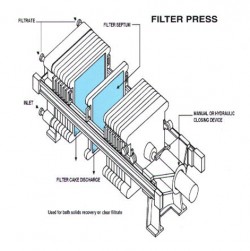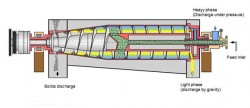 Sludge handling involves many unit operations like Sludge Thickening, Conveying, dewatering and disposal.
Sludge handling involves many unit operations like Sludge Thickening, Conveying, dewatering and disposal.
a. Sludge Thickener:
A Sludge thickener is primary dewatering equipment where the raw sludge of 0.5 – 1% sludge from the clarifier is dewatered to 4 – 6 % solids. Normally thickeners are RCC constructed however Glass or steel construction is also preferred.
The thickener is equipped with very slow speed scraper at the bottom & vessel geometry is such that sedimentation is assisted. The clear overflow is collected in launder through adjustable weirs.
In sludge thickening operation, raw sludge from the Sewage/Effluent Treatment Plant is taken to specially built Thickener Unit. The solids settle further resulting into thicker slurry. The overflow which is very low in suspended solids is taken back to the equalisation tank or Aeration tank inlet as the case may be.
The thickened sludge is further dewatered with either Filter Press or Centrifuge. In places land is not a scarce resource Sludge Drying Beds are used.
b. Filter Press:
The thickened sludge from thickener is taken to Filter Press for further dewatering.
Filter press which describes the type of filters developed from the 19th century onwards originally for clay. The majority of today’s filters are more correctly called “chamber filter press”, or “Membrane Plate Filter”. Many processes in the food, chemical or pharmaceutical industries make products from liquid-solid suspensions or slurries. These mixtures are like a runny mud or thick milk shake. The solids in them do not dissolve, but are in suspension & carried along in it. Filter presses separate the solids from the liquids so that the useful part can be re-processed, packaged or delivered to the next step.
Filter presses generally work in a “batch” manner. They are loaded with slurry before completing a filtering cycle and producing a batch of solid filtered material, called the filter cake. The solid is removed, the press is re-loaded with slurry and the filtering cycle repeated.
A filter press uses pressure to maximize the rate of filtration and produce a final filter cake with water content < 65%.
A filter press consists of a series of filter chambers containing square, rectangular plates supported in a frame. Once the filter chambers are loaded with slurry, the filter plates are forced together with hydraulic rams that generate pressures typically in the region of 100 pounds per square inch.
In addition to the filter plate filtration medium, the growing filter cake enhances removal of fine particles in the slurry. The solution coming through the filter press water bib cocks is called the filtrate, will be pure.
The filtrate can be drained away for safe disposal, however usually it is recycled back to the main process. At the end of filtration, the solid filter cake can be removed. The whole filtration process is often automatic or semi-automatic for easier operation.
The filter press is suitable for almost all types of sludge:
Hydrophilic organic sludge: inorganic conditioning is often recommended to enable satisfactory cake release due to minimal adherence to filter cloth.
Hydrophilic inorganic sludge: the filer press generally requires the addition of lime only.
Hydrophobic inorganic sludge: it is very dense and ideal for the filter press. It is dewatered without any preliminary conditioning.
Oily sludge: the filter press can be used to treat sludge containing light oils, the presence of grease can sometimes impair the smooth running of the filter; clothes have to be degreased at frequent intervals.
A schematic of Filter Press is given in picture:
 c. Decanter (Sludge Centrifuge):
c. Decanter (Sludge Centrifuge):
The centrifuge in principle is completely different from gravity separation. With centrifugation it is the centrifugal force instead of gravity that is used to force the solid/liquid separation. This force is created in a conical-cylinder bowl that rotates at high speed (2500-3500 rpm). The sludge particles are pressed against the bowl and conveyed out of the centrifuge by a screw that rotates at a slightly different speed than the bowl (a few rpm).
The principle of a centrifuge, also known as centrifugal decanter, uses centrifugal force to accelerate solid-liquid separation. To simplify, it can be assumed that a centrifuge is a conical cylinder decanter that turns horizontally on its axis with a clarified water overflow, the dewatered sludge being removed by an Archimedean screw. The rotation applies a centrifugal force on the solid particles that then move a lot more quickly. In practice, the flocculated sludge is injected inside the centrifuge bowl through an injection pipe. The bowl has a high rotation speed (3500 rpm) and the particles are flattened against the bowl’s sides in the clarification zone. The particles are then pushed by an Archimedean screw towards the end of the bowl’s cone in the sludge spin-dry zone. The clarified liquid called, centrate, is evacuated at the other end of the bowl by overflow.
Inefficient sludge treatment leads to low-quality effluent, reduces sludge solids content, increases disposal costs, and necessitates sludge rework.
Mechanical assistance (centrifuge, vacuum, pressure) can increase the drainage rate and the amount of water released from sludge, but the best dewatering performance requires optimization of both chemical treatment and mechanical equipment.
A schematic of Centrifuge is given above picture:
